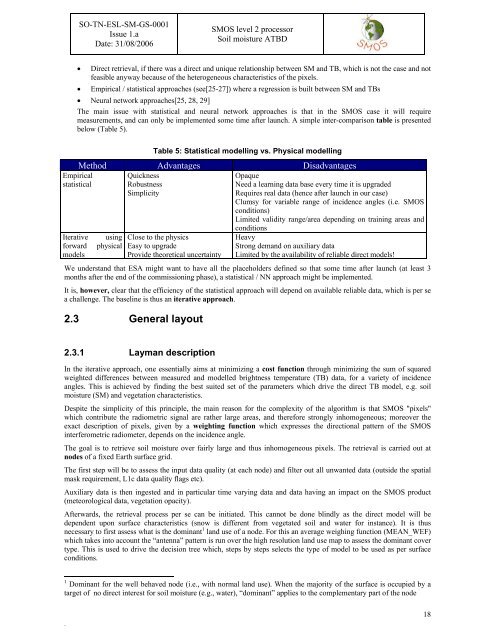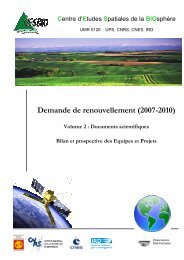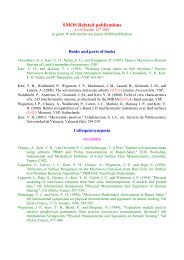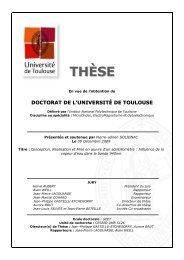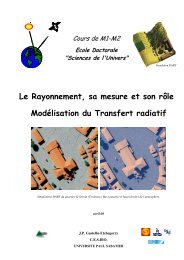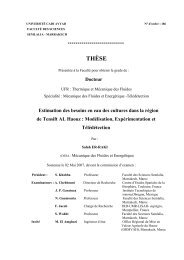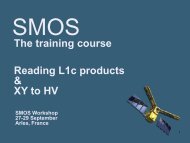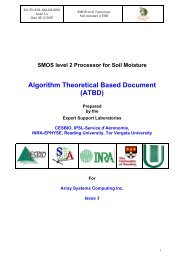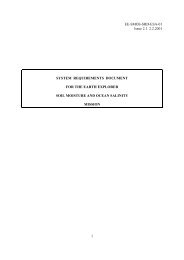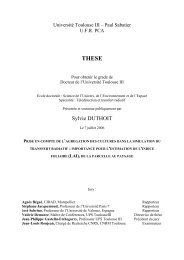Algorithm Theoretical Based Document (ATBD) - CESBIO
Algorithm Theoretical Based Document (ATBD) - CESBIO
Algorithm Theoretical Based Document (ATBD) - CESBIO
You also want an ePaper? Increase the reach of your titles
YUMPU automatically turns print PDFs into web optimized ePapers that Google loves.
SO-TN-ESL-SM-GS-0001<br />
Issue 1.a<br />
Date: 31/08/2006<br />
SMOS level 2 processor<br />
Soil moisture <strong>ATBD</strong><br />
• Direct retrieval, if there was a direct and unique relationship between SM and TB, which is not the case and not<br />
feasible anyway because of the heterogeneous characteristics of the pixels.<br />
• Empirical / statistical approaches (see[25-27]) where a regression is built between SM and TBs<br />
• Neural network approaches[25, 28, 29]<br />
The main issue with statistical and neural network approaches is that in the SMOS case it will require<br />
measurements, and can only be implemented some time after launch. A simple inter-comparison table is presented<br />
below (Table 5).<br />
Table 5: Statistical modelling vs. Physical modelling<br />
Method Advantages Disadvantages<br />
Quickness<br />
Robustness<br />
Simplicity<br />
Empirical<br />
statistical<br />
Iterative<br />
forward<br />
models<br />
using<br />
physical<br />
Close to the physics<br />
Easy to upgrade<br />
Provide theoretical uncertainty<br />
Opaque<br />
Need a learning data base every time it is upgraded<br />
Requires real data (hence after launch in our case)<br />
Clumsy for variable range of incidence angles (i.e. SMOS<br />
conditions)<br />
Limited validity range/area depending on training areas and<br />
conditions<br />
Heavy<br />
Strong demand on auxiliary data<br />
Limited by the availability of reliable direct models!<br />
We understand that ESA might want to have all the placeholders defined so that some time after launch (at least 3<br />
months after the end of the commissioning phase), a statistical / NN approach might be implemented.<br />
It is, however, clear that the efficiency of the statistical approach will depend on available reliable data, which is per se<br />
a challenge. The baseline is thus an iterative approach.<br />
2.3 General layout<br />
2.3.1 Layman description<br />
In the iterative approach, one essentially aims at minimizing a cost function through minimizing the sum of squared<br />
weighted differences between measured and modelled brightness temperature (TB) data, for a variety of incidence<br />
angles. This is achieved by finding the best suited set of the parameters which drive the direct TB model, e.g. soil<br />
moisture (SM) and vegetation characteristics.<br />
Despite the simplicity of this principle, the main reason for the complexity of the algorithm is that SMOS "pixels"<br />
which contribute the radiometric signal are rather large areas, and therefore strongly inhomogeneous; moreover the<br />
exact description of pixels, given by a weighting function which expresses the directional pattern of the SMOS<br />
interferometric radiometer, depends on the incidence angle.<br />
The goal is to retrieve soil moisture over fairly large and thus inhomogeneous pixels. The retrieval is carried out at<br />
nodes of a fixed Earth surface grid.<br />
The first step will be to assess the input data quality (at each node) and filter out all unwanted data (outside the spatial<br />
mask requirement, L1c data quality flags etc).<br />
Auxiliary data is then ingested and in particular time varying data and data having an impact on the SMOS product<br />
(meteorological data, vegetation opacity).<br />
Afterwards, the retrieval process per se can be initiated. This cannot be done blindly as the direct model will be<br />
dependent upon surface characteristics (snow is different from vegetated soil and water for instance). It is thus<br />
necessary to first assess what is the dominant 1 land use of a node. For this an average weighing function (MEAN_WEF)<br />
which takes into account the “antenna” pattern is run over the high resolution land use map to assess the dominant cover<br />
type. This is used to drive the decision tree which, steps by steps selects the type of model to be used as per surface<br />
conditions.<br />
1 Dominant for the well behaved node (i.e., with normal land use). When the majority of the surface is occupied by a<br />
target of no direct interest for soil moisture (e.g., water), “dominant” applies to the complementary part of the node<br />
.<br />
18


